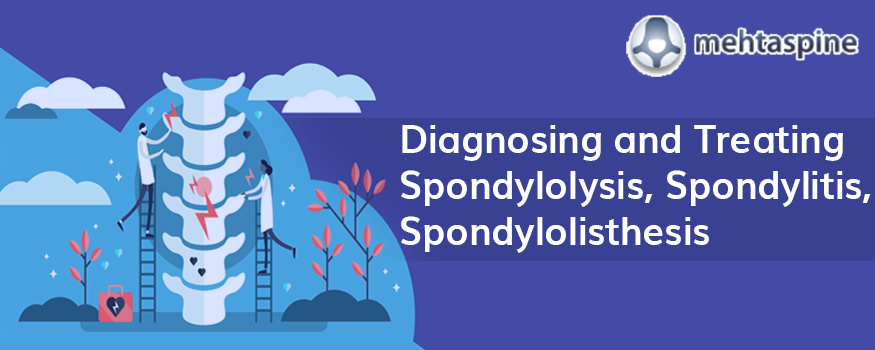Diagnosing and Treating Spondylolysis, Spondylitis, Spondylolisthesis
The spine is an important part of the human anatomy as it protects our spinal cord, a vital organ supporting our body weight. The spine is made up of 33 little bones called vertebrae, these are stacked on top of one another with fibrous discs in between them. The small bones are interlocked with each other by ligament supported facet joints.
The anatomy of the spine consists of the Cervical, Thoracic, Lumbar, Sacral, and Coccyx regions.
- Cervical Spine (neck): This part is located in the upper portion of the spine and comprises 7 vertebrae that support the head and the neck.
- Thoracic Spine (mid-back): This part is located in the torso region and consists of 12 vertebrae that support the torso.
- Lumbar Spine (lower back): This part is composed of 5 large vertebrae and supports our body’s weight and mass.
- Sacrum
- Coccyx
The three major parts are the Cervical, Thoracic, and Sacral regions.
Spine Deformities: Spinal deformities or spine alignment can be caused because of many things like sitting in a wrong posture, birth defect, aging, some spine surgery, or a child’s growth. There are a lot of spine deformities and here are three:
- Spondylolisthesis: Spondylolisthesis is a medical condition in which one vertebra of the spine slides forward onto the other one which causes the nerve running through the spine to be squished. This causes excruciating pain.
- Diagnosing Spondylolisthesis: The doctor checks for the difficulty in raising the leg straight outward during simple exercises. Then the doctor moves on X-rays and CT scans for a detailed view of the vertebrae.
- Treatment
Nonsurgical methods: These include anti-inflammatory drugs and exercises.
Surgical methods: In this, the surgeon used a bone graft to keep the vertebrae in place.
While the success rate of the surgery is very high, nonsurgical methods are recommended first before performing the surgery.
- Spondylolysis :It is a degenerative condition affecting the next and lowers back. In this, the bone attaching the facet joints at the back of the spine gets deteriorated.
- Diagnosing: It is diagnosed by checking for lower back or next pain during a one-legged hyperextension of the spine. X-rays and MRI scans also help in diagnosis.
- Treatment: Usually, the condition is healed through braces, medication, and exercises. If that doesn’t help, then spinal decomposition surgery is effective.
- Spondylitis :It is a type of inflammatory rheumatic arthritis that affects the areas where ligaments and tendons attach to the bone.
- Diagnosing Spondylitis: The condition is diagnosed through a physical exam where medical and family history is also reviewed. Diagnosing imaging and blood work-testing for gene HLA-B27 helps to pinpoint the condition.
- Treatment: There is no cure for this condition. Physical exercise and medication manage pain and stiffness while surgeries like laminectomy and spinal fusion surgery are more effective in severe cases.
Conclusion
Almost everyone has some sort of spinal deformity and to help improve that, proper diagnosis and treatment are necessary. Many great surgeons are available for spinal care and treatment in the UK like Dr. Jwalant S.Mehta, a children and adult spine surgeon based in the Royal Orthopaedic Hospital, Birmingham. He also has one of the spondylolysis treatments in the UK, healing not just the disease but the patient.


